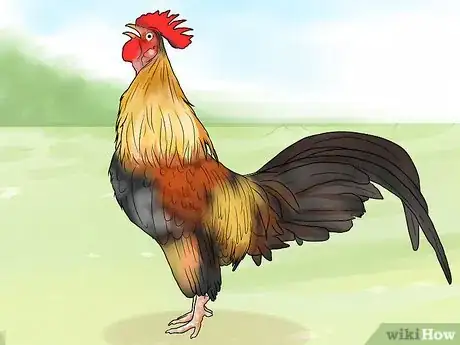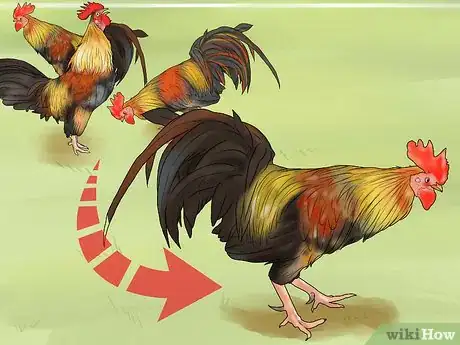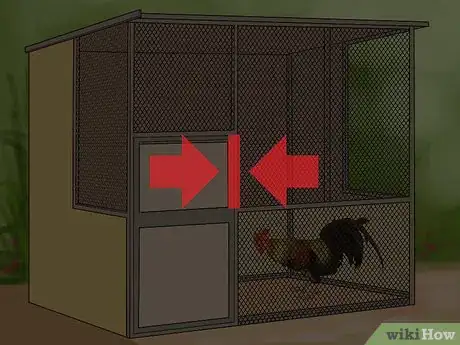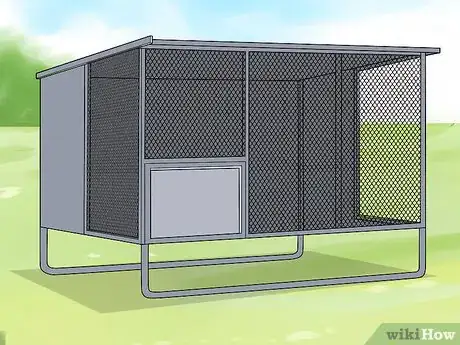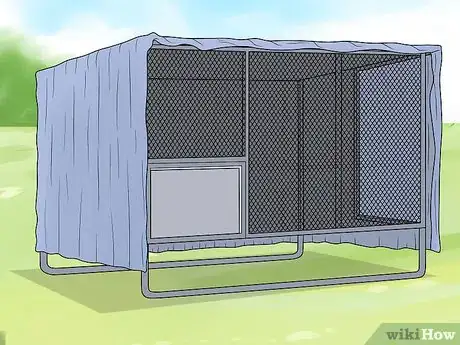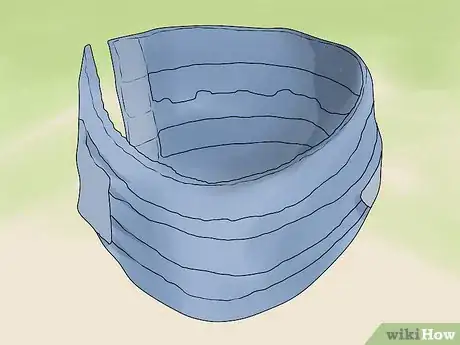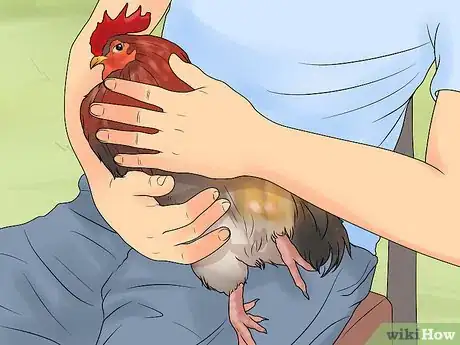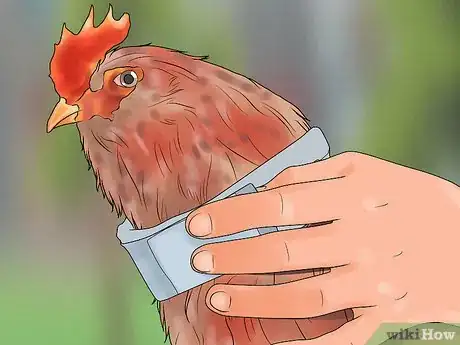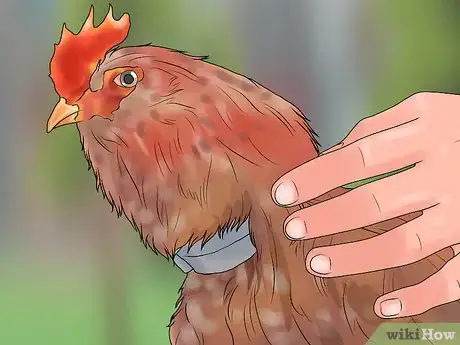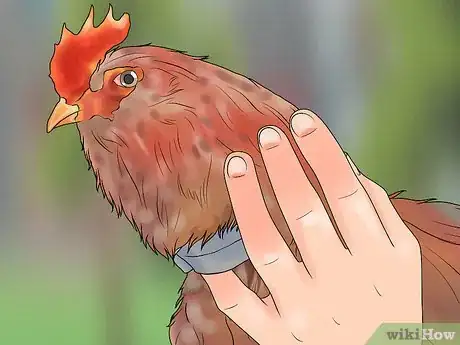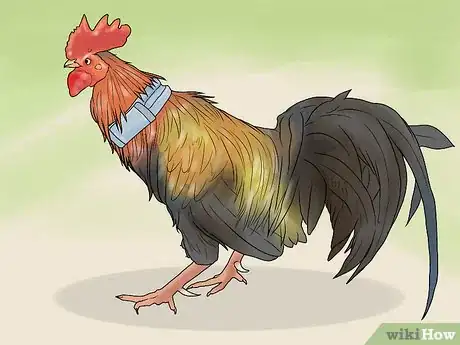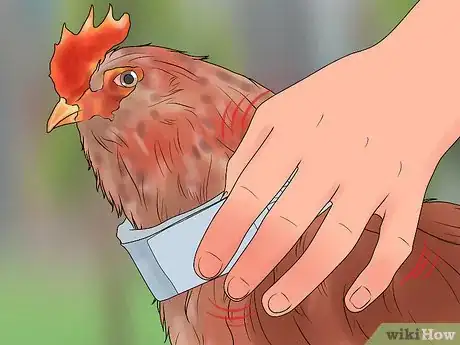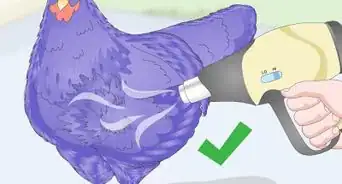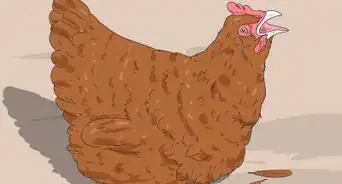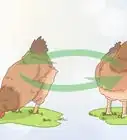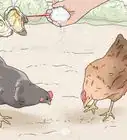wikiHow is a “wiki,” similar to Wikipedia, which means that many of our articles are co-written by multiple authors. To create this article, 13 people, some anonymous, worked to edit and improve it over time.
wikiHow marks an article as reader-approved once it receives enough positive feedback. This article has 11 testimonials from our readers, earning it our reader-approved status.
This article has been viewed 343,290 times.
Learn more...
With the rise of urban and suburban farming, the presence of roosters in the city and the burbs is becoming increasingly common. Rooster, as you may have discovered, do not just crow at sunrise. On average, a rooster may crow between 12 to 15 times a day! It is not possible to silence your rooster’s crow, but you can decrease the volume of their signature sound by adjusting your rooster’s lifestyle, turning his coop into a blackout box, or placing a collar around his neck.[1]
Steps
Adjusting Your Rooster’s Lifestyle
-
1Learn your rooster’s crowing habits. The rooster is responsible for protecting his flock. He crows to inform the flock of environmental changes and potential hazards. Observe your rooster’s crowing habits and note specific stimuli that causes him to crow.[2]
-
2Meet your rooster’s needs. In addition to alerting his flock to potential dangers, a rooster may crow to inform you that he is out of feed and or water. Meeting his most basic needs on a consistent and regular basis will decrease his need to crow. To decrease his nighttime crowing, make sure to stock his coop with water and food before you head to bed.[3]Advertisement
-
3Decrease the size of your flock. Roosters crow to assert their dominance over other roosters and to communicate with their flock. To avoid crowing matches between roosters, only keep one in the roost. Decreasing the size of your flock will reduce your rooster’s need to crow as well.[4]
-
4Limit your rooster’s exposure to nighttime stimuli. Crowing is most disruptive to you and your neighbors throughout the night. When a rooster is allowed to roam at night or he lives in a coop with an outdoor run, he is exposed to stimuli that will likely cause him to crow. Keeping your rooster inside a closed, darkened coop throughout the night will limit his exposure to predators and light that may cause him to crow.[5]
Converting a Raised Dog Crate into a Blackout Box
-
1Gather the required materials and find a suitable location. A blackout box provides your rooster with a dark, non-stimulating sleeping environment. You can often locate the materials required to build a blackout box around your home or purchase them from a local pet supply store. If you intend to keep the blackout box outside, find a shady location. If you prefer to house your rooster’s indoors, place the blackout box in your garage or outbuilding.[6]
-
2Assemble and prepare the raised dog crate. A raised dog crate serves as an ideal blackout box because his raised bed provides ventilation and you can easily cover the kennels’ holes. Assemble the crate in the location you selected—follow the instructions provided by the manufacturer. Remove any dog bedding and cover the floor of the crate with a layer of hay.[7]
-
3Cover the crate’s holes. The walls of your dog crate may be solid, slotted, or wire. To effectively block out light, drape the top, back, and side walls with blackout drapes. Purchase or cut a piece of plywood that is the same dimensions as the front wall. Lay the plywood against the front of the crate.[8]
Making or Purchasing a Rooster Collar
-
1Purchase or make a rooster collar. A Rooster collar limits the airflow to a rooster’s voice box, which reduces the volume of his crows. You can purchase a rooster collar or make your own.[9]
- To make your own collar you will need double-sided Velcro. The velcro should be 2 inches wide. Cut a 6 to 8 inch piece of velcro. Adhere the back sides of the velcro to each other.[10]
-
2Secure the rooster in your lap with both hands. Place the rooster in your lap—his head should face away from you. Circle your thumb and index finger of your non-dominant hand around his neck. Lift his feathers by moving your hands up his neck.[11]
-
3Place the collar on the back of the rooster’s neck. Use your dominant hand to grab the collar. Lay one end of the collar on the back of the rooster’s neck. Use the thumb encircling the rooster’s neck to hold the collar in place.[12]
- Position the collar low on the rooster’s neck.
-
4Wrap the collar around the rooster’s neck and secure it. As you continue to hold the collar with your thumb, use your dominant hand to wrap the collar around the rooster’s neck. Overlap the collar and secure the velcro. Carefully align the lengths of the collar.[13]
-
5Make sure the collar is not too tight. It is essential that you assess the fit of your rooster’s collar.[14]
- Insert your pinky finger between the collar and the rooster’s neck. Your pinky finger should slide under the collar’s top and bottom edges.
- Listen to the rooster’s breathing. If he is struggling to get air, loosen the collar. Continue to check on him often.
-
6Allow your rooster to acclimate to the collar. When you first put on the collar, your rooster may jump backwards and try to remove the collar. Work with your rooster to help him get used to wearing the collar.
- For the first day, keep the collar loose.
- As you gradually tighten the collar, reward your rooster with treats.
-
7Adjust the collar as needed. It may be necessary to adjust the fit of the collar. Check the fit of the collar from time to time. Pay special attention to your young rooster—adjust the collar as your rooster grows.
Community Q&A
-
QuestionWhy do roosters crow in the morning?
 wikiHow Staff EditorThis answer was written by one of our trained team of researchers who validated it for accuracy and comprehensiveness.
wikiHow Staff EditorThis answer was written by one of our trained team of researchers who validated it for accuracy and comprehensiveness.
Staff Answer wikiHow Staff EditorStaff AnswerRoosters tend to crow upon waking up, and since roosters tend to wake up prior to sunrise. We’re more likely to assume this is dawn than earlier because humans tend to wake up at dawn, not earlier. It’s likely their crowing is in part a response to waking up ("Hey guys! I’m awake now!") and when the sun starts to shine through their coop, they respond to the light as well. Also, early morning crowing is often a territorial and dominance establishing ritual, especially if there is more than one rooster or they can hear each other across different yards; it is the dominant rooster that crows first, followed by the subordinate roosters. As the morning goes on, most other forms of rooster crowing are likely forms of varied communications, like being bothered by something or showing off to the hens in courtship displays.
wikiHow Staff EditorStaff AnswerRoosters tend to crow upon waking up, and since roosters tend to wake up prior to sunrise. We’re more likely to assume this is dawn than earlier because humans tend to wake up at dawn, not earlier. It’s likely their crowing is in part a response to waking up ("Hey guys! I’m awake now!") and when the sun starts to shine through their coop, they respond to the light as well. Also, early morning crowing is often a territorial and dominance establishing ritual, especially if there is more than one rooster or they can hear each other across different yards; it is the dominant rooster that crows first, followed by the subordinate roosters. As the morning goes on, most other forms of rooster crowing are likely forms of varied communications, like being bothered by something or showing off to the hens in courtship displays. -
QuestionWhat does it mean when a rooster crows?
 wikiHow Staff EditorThis answer was written by one of our trained team of researchers who validated it for accuracy and comprehensiveness.
wikiHow Staff EditorThis answer was written by one of our trained team of researchers who validated it for accuracy and comprehensiveness.
Staff Answer wikiHow Staff EditorStaff AnswerRoosters crow as a form of communication, just like humans talk to each other. Crowing can mean many different things, such as letting other roosters and hens know where they are, establishing dominance in the face of other roosters (telling then "this is my territory"), scaring away potential predators, showing off to the hens, responding to sounds they’ve heard (including roosters heard far away), reacting to light, etc.
wikiHow Staff EditorStaff AnswerRoosters crow as a form of communication, just like humans talk to each other. Crowing can mean many different things, such as letting other roosters and hens know where they are, establishing dominance in the face of other roosters (telling then "this is my territory"), scaring away potential predators, showing off to the hens, responding to sounds they’ve heard (including roosters heard far away), reacting to light, etc. -
QuestionWhy do roosters crow in the middle of the night?
 wikiHow Staff EditorThis answer was written by one of our trained team of researchers who validated it for accuracy and comprehensiveness.
wikiHow Staff EditorThis answer was written by one of our trained team of researchers who validated it for accuracy and comprehensiveness.
Staff Answer wikiHow Staff EditorStaff AnswerA rooster crowing in the middle of the night might be responding to another rooster he has heard or perhaps he is dealing with a disturbance in the coop, like hens getting upset for some reason, a flash of a car light, or to warn the coop inhabitants of an intruder, like a fox. Roosters have an acute sense of hearing, so they’re easily disturbed and if so, they’re usually making a noise to either warn of or ward off possible dangers in the dark. Or, a rooster may just decide that having a bit of crow in the middle of the night will alleviate his boredom, especially if he wakes up early and the other chickens are still asleep.
wikiHow Staff EditorStaff AnswerA rooster crowing in the middle of the night might be responding to another rooster he has heard or perhaps he is dealing with a disturbance in the coop, like hens getting upset for some reason, a flash of a car light, or to warn the coop inhabitants of an intruder, like a fox. Roosters have an acute sense of hearing, so they’re easily disturbed and if so, they’re usually making a noise to either warn of or ward off possible dangers in the dark. Or, a rooster may just decide that having a bit of crow in the middle of the night will alleviate his boredom, especially if he wakes up early and the other chickens are still asleep.
References
- ↑ http://www.weedemandreap.com/how-to-stop-rooster-crowing/
- ↑ http://animals.mom.me/keep-roosters-quiet-night-9250.html
- ↑ http://animals.mom.me/keep-roosters-quiet-night-9250.html
- ↑ http://animals.mom.me/keep-roosters-quiet-night-9250.html
- ↑ http://animals.mom.me/keep-roosters-quiet-night-9250.html
- ↑ http://www.blokespost.com/house-family/pets/stop-chickens-clucking-in-the-morning/4252
- ↑ http://www.blokespost.com/house-family/pets/stop-chickens-clucking-in-the-morning/4252
- ↑ http://www.blokespost.com/house-family/pets/stop-chickens-clucking-in-the-morning/4252
- ↑ http://www.weedemandreap.com/how-to-stop-rooster-crowing/
- ↑ http://www.weedemandreap.com/how-to-stop-rooster-crowing/
- ↑ http://www.mypetchicken.com/downloads/NoCrowCollarInstructions.pdf
- ↑ http://www.mypetchicken.com/downloads/NoCrowCollarInstructions.pdf
- ↑ http://www.mypetchicken.com/downloads/NoCrowCollarInstructions.pdf
- ↑ http://www.mypetchicken.com/downloads/NoCrowCollarInstructions.pdf
About This Article
To stop a rooster from crowing, make a collar out of double-sided Velcro to restrict the flow of air to its voice box and reduce the volume of its crowing. To put on the collar, place the rooster on your lap with its head facing away from you. Then, push up the feathers around its neck, wrap the collar around it, and secure the Velcro. Afterwards, check that the collar isn't too tight by sliding your pinky between the collar and the rooster's neck. For more advice, like how to stop your rooster from crowing by adjusting its lifestyle, keep reading.
